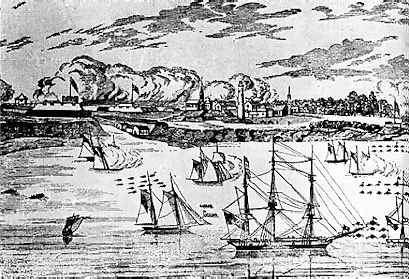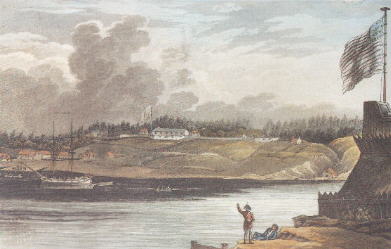Our sites:
Home
of
Access Heritage Inc (formerly The Discriminating General)
The Napoleonic Wars Collection
Military Music Sound Clip Gallery
Products and Services:
British Army Products 1793-1815
British Army Products 1816-1856

Articles - Reenactments and Units - Book Reviews - Quizzes - Replicas - Links - Chart of British Regiments - Sound Clips - Prints for Sale - Animated GIF Battles - Chronology of Events - Video Clips
The Capture of Fort George,
May 27th, 1813

American Landing at Fort George
The spring of 1813 marked a change in the fortunes of the Army of the United States. The capital of Upper Canada, York (present day Toronto) had been captured, looted, jails opened public buildings damaged and military structures destroyed. However the victory had come at an expensive price with the death of the US’s most able general, Zebulon Pike.
The amphibious attack on York had showed to the British how vulnerable their supply line was to the Niagara peninsula and had forced badly needed reinforcements back to Kingston, 200 miles further away from Niagara’s principal garrison, Fort George. To the American General Henry Dearborn across the river at Fort Niagara the time was right for an all-out invasion of Upper Canada.
On May 25, American batteries along the Niagara river and at Fort Niagara opened fire on Fort George damaging or destroying almost all the buildings within its walls. Only the casemates within the Fort’s walls themselves offered protection for the garrison’s soldiers, women and children. This bombardment signaled to the British commander, Brigadier General John Vincent that an invasion was imminent. But where would the invasion land? Would the American army land along the river under protection of their batteries in front of Fort George or would they come ashore on the lakeside on the other side of the village of Niagara (present day Niagara-on-the-Lake, also referred to at the time by its first name Newark) away from the guns of Fort George?
Gunner, United States Artillery, 1813 by H.C.
McBarron
(courtesy of Parks Canada)
On May 26, Dearborn began to embark his troops. The plan decided upon was that the light troops would first land on the lakeshore led by Winfield Scott and Benjamin Forsyth, and secure the beach head for the rest of the brigades to land. The early next morning on May 27, the American fleet with the invasion force under cover of a heavy fog. With no breeze in the air it was slow moving for the flotilla. The fog soon lifted to reveal that the Americans were on the move. While the element of surprise had been removed, Vincent still did not know were the Army would land. With only 1200 troops available and unable to cover all possible landing spots, Vincent chose to withdrew troops from the lakeshore and concentrated them on the river. He chose wrong.
Once the landing boats left the American flotilla and it became obvious that the lakeshore was their destination, Vincent scrambled to re-direct troops back to Lake Ontario. The light troops, two companies of the Glengarry Light Infantry Fencibles and one of the Royal Newfoundland Fencibles and militia were dispatched from his force to meet the American landing. Rushing into action, the Canadians charged the disembarking Americans under Scott with the bayonet. While climbing out of his boat, Scott himself was forced to dodge a bayonet from a Glengarry, but falling into the cool waters of Lake Ontario. As wave after wave of thousands of US regulars landed the Canadian troops were slowly beaten back and retired to a position held by the 8th Regiment. Further attempts were made, this time by the 49th Regiment and militia, to halt the American advance but without success.
Outnumbered and in the process of being outflanked, Vincent decided to make a hasty evacuation of Fort George. So fast was the pullout and under constant bombardment from Fort Niagara, that the women and children of the 49th and other corps were left behind in the casements of the fort. To avoid the American army moving from the shores of Lake Ontario towards Fort George, Vincent retreated up the Niagara river to Queenston then cut north with detachments from Fort Erie and Queenston towards Burlington Heights (north of present day Hamilton) leaving the Niagara peninsula under US control. While Washington was pleased with this success, the hope of the invasion was to destroy completely Vincent’s small army leaving Upper Canada west of Kingston at the mouth of the St. Lawrence in the hands of the US. The US army then could deal with British on the Detroit river at their leisure. But this was not the case.

View of Fort George from Fort Niagara, 1811(Library and Archives of Canada)
(purchase this print by clicking
here)
Copyright: Access Heritage Inc (formerly The Discriminating General) 1998
© Copyright: Unless otherwise noted, all information, images, data contained within this website is protected by copyright under international law. Any unauthorized use of material contained here is strictly forbidden. All rights reserved.

